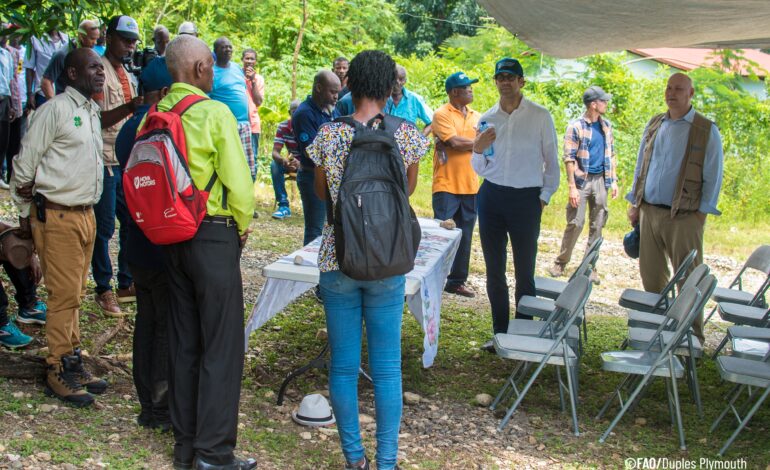
FAO remains committed to delivering urgent agricultural support for the upcoming planting seasons.
This week, Rein Paulsen, Director of FAO’s Office of Emergencies and Resilience, along with Adoniram Sanches, FAO’s Subregional Coordinator for Mesoamerica, visited Haiti to support the incoming FAO Representative, Pierre Vauthier in bolstering international cooperation and rising awareness on the dire humanitarian situation on the ground.
During their visit, FAO officials met with Prime Minister Garry Conille, as well as Agriculture Minister Vernet Joseph and Environment Minister Moïse Fils Jean Pierre. They also held meetings with representatives from USAID, the World Bank, the European Union, and the Spanish Agency for International Development Cooperation (AECID), as well as other UN agencies and programes.
Alarming food insecurity in Haiti
Since February 2024, escalating violence and increased population displacements have significantly reduced agricultural production and disrupted markets, leaving half of Haiti’s population in acute hunger. Nearly five million people are experiencing high levels of acute food insecurity and around 125 000 children suffer from severe acute malnutrition. FAO is calling on the international community to secure USD 48 million under the 2024 Humanitarian Response Plan, to assist 608 000 people with emergency agriculture activities.
“FAO remains committed to providing urgent agricultural support for the upcoming planting seasons, but additional funding is needed to save lives, prevent hunger and famine, and help vulnerable populations restore their livelihoods amidst unprecedented violence and displacement”, said Rein Paulsen.
FAO’s priorities
FAO has shown that local food production and access to seeds are sustainable and cost-effective solutions, essential to preventing a larger food crisis. An analysis by the FAO Data in Emergencies Hub underscores that agricultural activities offer a buffer against violence and insecurity, allowing rural families to produce their own food.
In crisis-affected, urban, peri-urban and rural populations in the Metropolitan Area of Port-au-Prince and Grand’Anse department, FAO aims to improve access and availability of food for vulnerable households. The specialized Agency of the United Nations plans to support displaced and host families through cash, by combining the provision of cash transfers with agricultural input packages and training. This approach enables crisis-affected households to meet their immediate needs, while engaging in food production for household consumption and to generate income, as well as maintaining their productive assets. Depending on the local circumstances, recipients may be provided with either cash, agricultural inputs, training or a combination of these types of assistance.
With alarming levels of acute malnutrition, particularly in regions such as Artibonite and the Metropolitan Area of Port-au-Prince, FAO is also focused and prepared on providing nutritional assistance to over 276 000 children at risk of malnutrition. However, without a significant increase in funding, FAO’s efforts to mitigate this humanitarian crisis will be severely compromised, affecting the survival of hundreds of thousands of people.
Field visit to Grand’Anse
During their field visit, Paulsen and Sanches, accompanied by the Ambassador of Canada, André François Giroux; the Deputy Ambassador of the United States, Usha Elizabeth Pitts; and the Director General of the Ministry of Agriculture, Moise Elancie; oversaw the results of previous key emergency and resilience initiatives, specifically in key value chains like milk production as well as vegetable, small livestock production, and school feeding program in the commune of Marfranc.
Agriculture remains a critical lifeline for 75% of the people affected by food insecurity in Haiti. Providing crisis-affected households, including internally displaced people and host communities, with urgent emergency agricultural support is essential for survival, and to boost food production and restore their livelihoods. However, insufficient funding remains a critical obstacle. The cost of inaction is high since affected population will be more vulnerable with increased humanitarian assistance needs. Not investing now in agriculture emergencies and resilience will cost more.
Evidence from 2023 FAO interventions show that an investment of USD 480 can support a family of five people to grow staple food for up to six months, and an investment of USD 200 provided 100 grams of seed, and enabled households to produce on average ten different types of nutritious vegetables worth around USD 2 500 on the local market.





